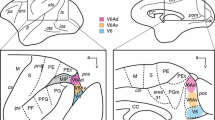Summary
Cells in area 17 of the cortex are generally activated either directly through a retino-thalamic pathway or indirectly via a contralateral hemispherecallosal pathway. The aim of the present experiment was to evaluate the effects of eliminating this second pathway on the binocular activation of cells in the primary visual cortex. The optic tract was sectioned on one side in 18 cats and unit activity was recorded in the contralateral hemisphere. This hemisphere should receive normal thalamo-cortical inputs but no visual callosal input. These animals were compared to 21 normal cats. Extracellular electrophysiological recordings were carried out in the conventional way using tungsten microelectrodes and N2O anaesthesia. Results indicated that the proportion of binocular cells found in the cortex of tract sectioned animals was lower than that found in normal animals. However, this decrease in binocularity could be essentially attributed to cells having receptive fields situated to within 4 ° of the vertical meridian of the visual field. These results are interpreted as being congruent with the demonstrated anatomo-physiological projections of the callosal system.
Similar content being viewed by others
References
Albus K (1975) Predominance of monocularly driven cells in the projection area of the central visual field in cat's striate cortex. Brain Res 89: 341–347
Berlucchi G, Rizzolatti G (1968) Binocularly driven neurons in visual cortex of split-chiasm cats. Science 159: 308–310
Berlucchi G, Gazzaniga MS, Rizzolatti G (1967) Microelectrode analysis of transfer of visual information by the corpus callosum. Arch Ital Biol 105: 583–596
Berman N, Hazel Murphy E, Salinger WL (1979) Monocular paralysis in the adult cat does not change cortical ocular dominance. Brain Res 164: 290–293
Bishop PO, Kozak W, Vakkur GJ (1962) Some quantitative aspects of the, cat's eye: Axis and plane of reference of visual field coordinates and optics. J Physiol (Lond) 163: 466–502
Fernald R, Chase R (1971) An improved method for plotting retinal landmarks and focusing the eyes. Vision Res 11: 95–96
Hubel DH, Wiesel TN (1962) Receptive fields, binocular interaction and functional architecture in the cat's visual cortex. J Physiol (Lond) 160: 106–154
Hubel DH, Wiesel TN (1967) Cortical and callosal connections concerned with the vertical meridian of visual fields in the cat. J Neurophysiol 30: 1561–1573
Innocenti GM (1980a) The primary visual pathway through the corpus callosum: Morphological and functional aspects in the cat. Arch Ital Biol 118: 124–188
Innocenti GM (1980b) Adult and neonatal characteristics of the callosal zone at the boundary between areas 17 and 18 in the cat. In: Steele-Russell I, Van Hof MW, Berlucchi G (eds) Structure and function of cerebral commissures. University Park Press, Baltimore, pp 244–258
Lepore F, Guillemot JP (1982) Visual receptive field properties of cells innervated through the corpus callosum in the cat. Exp Brain Res 46: 413–424
Payne BR, Elberger AJ, Berman N, Murphy EH (1980a) Binocularity in the cat visual cortex is reduced by sectioning the corpus callosum. Science 207: 1097–1099
Payne BR, Berman N, Murphy EH (1980b) Loss of binocularity in area 17 after section of the corpus callosum: Time course and extent of the visual field affected. Neurosci Abstr 6: 672
Sanides D (1980) Commissural connections of the visual cortex of the cat. In: Steele-Russell I, Van Hof MW, Berlucchi G (eds) Structure and function of the cerebral commissures. University Park Press, Baltimore, pp 236–243
Shoumura (1974) An attempt to relate the origin and distribution of commissural fibres to the presence of large and medium pyramids in layer III in the cat's visual system. Brain Res 67: 13–25
Siegel S (1956) Nonparametric statistics for the behavioral sciences. McGraw-Hill, New York
Author information
Authors and Affiliations
Additional information
This research was supported in part by grants from the Conseil de Recherches en Sciences Naturelles et en Génie du Canada and from the Ministère de l'Education (FCAC) du Québec
Rights and permissions
About this article
Cite this article
Lepore, F., Samson, A. & Molotchnikoff, S. Effects on binocular activation of cells in visual cortex of the cat following the transection of the optic tract. Exp Brain Res 50, 392–396 (1983). https://doi.org/10.1007/BF00239205
Received:
Issue Date:
DOI: https://doi.org/10.1007/BF00239205




